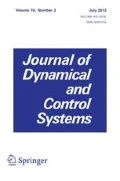Abstract
This paper deals with the finite time quenching phenomenon of positive radial solutions for p-Laplacian with singular boundary flux. We also discuss the corresponding quenching rate.
Similar content being viewed by others
References
Wu ZQ, Zhao JN, Yin JX, Li HL. Nonlinear diffusion equations: World Scientific Publishing; 2001.
Kawarada H. On solutions of initial-boundary problem u t =u x x +1/(1−u). Publ Res Inst Math Kyoto Univ 1975;10:729–736.
Boni T. On quenching of solutions for some semilinear parabolic equations of second order. Bull Belg Math Soc Simon Stevin 2000;7(1):73–95.
Dai Q, Gu Y. A short note on quenching phenomena for semilinear parabolic equations. J Diff Equ 1997;137:240–250.
Deng K, Levine HA. On the blow up of ut at quenching. Proc Amer Math Soc 1989;106(4):1049–1056.
Kirk CM, Roberts CA. A review of quenching results in the context of nonlinear Volterra equations, second international conference on dynamics of continuous. discrete and impulsive systems (London, ON). Dyn Contin Discret Impuls Syst Ser A Math Anal 2001;10(2003):343–356.
Levine HA. The quenching of solutions of linear hyperbolic and parabolic with nonlinear boundary conditions. SIAM J Math Anal 1983;14:1139–1153.
Levine HA. Quenching, nonquenching, and beyond quenching for solutions of some parabolic equations. Ann Mat Pura Appl 1989;155:243–260.
Levine HA, Montgomery JT. Quenching of solutions of some nonlinear parabolic problems. SIAM J Math Anal 1980;11:842–847.
Fila M, Levine HA. Quenching on the boundary. Nonlinear Anal TMA 1993; 21:795–802.
Chan WY. Quenching for nonlinear degenerate parabolic problems. J Comput Appl Math 2011;235(13):3831–3840.
Chan CY, Liu HT. Quenching for degenerate parabolic problems with nonlocal boundary conditions. Dynam Syst Appl 2009;18:17–28.
Chan CY, Jiang XO. Quenching for a degenerate parabolic problem due to a concentrated nonlinear source. Q Appl Math 2004;62:553–568.
Dyakevich NE. Exietence, uniqueness quenching properties of solutions for degenerate semilinear parabolic problems with second boundary conditions. J Math Anal Appl 2008;388:892–901.
Guo JS, Hu B. The profile near quenching time for the solution of a singular semilinear heat equation. Proc Edinburgh Math Soc 1997;40:437–456.
Ke L, Ning S. Quenching for degenerate parabolic problems. Nonlinear Anal 1998;34:1123–1135.
Deng K, Xu M. Quenching for a nonlinear diffusion equation with a singular boundary condition. Z Angew Math Phys 1999;50:574–584.
Yang Y, Yin JX, Jin CH. A quenching phenomenon for one-dimensional p-Laplacian with singular boundary flux. Appl Math Lett 2010;23:955–959.
Li XL, Mu CL, Zhang QN, Zhou SM. Quenching for a non-Newtonian filtration equation with a singular boundary condition. Abstr Appl Anal 2012; Art.ID 539161:13.
Nie YY, Zhou Q, Zhou MJ, Xu XL. Quenching phenomenon of a singular semilinear parabolic problem. J Dyn Control Syst 2015;21(1):81–93.
Acknowledgments
This work is partially supported by the National Science Foundation of China (11371153, 11471127,11201311,11301345), Specialized Research Fund for the Doctoral Program of High Educational of China, and Natural Science Foundation of SZU (201425,201545).
Author information
Authors and Affiliations
Corresponding author
Rights and permissions
About this article
Cite this article
Yang, Y., Yin, J. & Jin, C. Quenching Phenomenon of Positive Radial Solutions for p-Laplacian with Singular Boundary Flux. J Dyn Control Syst 22, 653–660 (2016). https://doi.org/10.1007/s10883-015-9287-2
Received:
Published:
Issue Date:
DOI: https://doi.org/10.1007/s10883-015-9287-2



